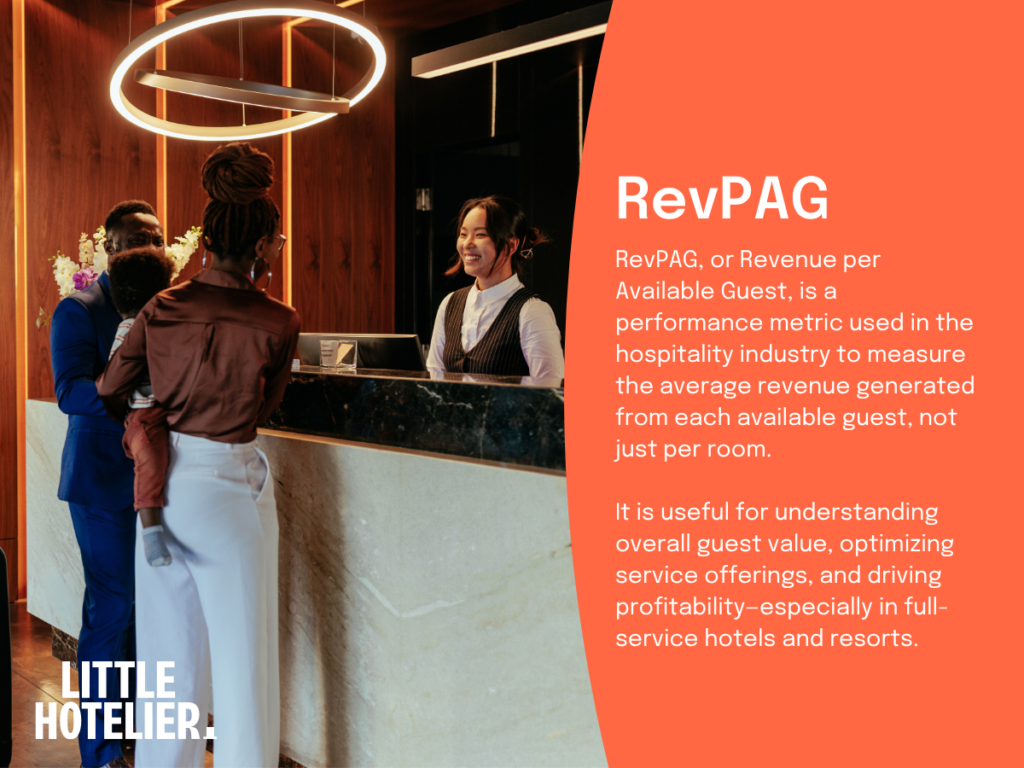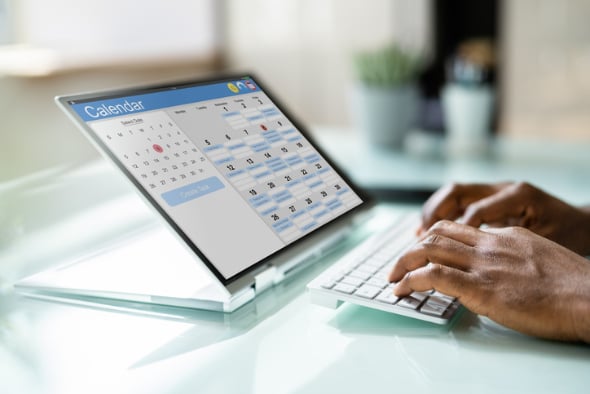What is RevPAG?
RevPAG is a performance metric used by hotels to measure how much revenue is generated per available guest at the property.
Unlike other common metrics such as RevPAR (revenue per available room), RevPAG goes beyond just room revenue – it gains a more holistic view of value by factoring in income from food and beverage, spa services, activities and other on-site purchases.
RevPAG is a particularly valuable measure for properties that place a strong focus on guest experience and amenities, like resorts, B&Bs and boutique hotels. It gives you a clear picture of total guest value, and lets you better evaluate your upselling, cross-selling and guest engagement strategies. As a result, it forces you to turn your focus from filling rooms to maximising guest satisfaction (and spend).
In this guide, we show you how to calculate revenue per guest using the RevPAG formula, we break down RevPAG vs RevPAR, and we reveal how small, independent hotels can capitalise this key metric.
An all-in-one platform to help maximise your RevPAG
Little Hotelier’s key reports and insights are designed to help small, independent hotels capitalise on revenue generation opportunities.
Learn moreWhy is RevPAG important for small hotels?
RevPAG is crucial for independent hotels because it reveals the broader picture of total guest value, rather than focusing on simpler metrics like occupancy or room rates. It can help to uncover hidden opportunities and maximise revenue.
With limited rooms available in a small hotel, every dollar counts. RevPAG captures all revenue generated by guests, which helps you to better understand how guests interact with your business, and where opportunities might lie to increase revenue without expanding your hotel or hiring more staff, i.e. it helps you make the most of what you’ve got.
If, for example, data shows that guests who book through certain channels spend more on add-on services, you can invest more in those channels. If breakfast sales are low, you might review the menu, the pricing, or how you advertise it to guests.
Key takeaways:
- It supports smarter, experience-focused hotel decision-making.
- RevPAG reveals total guest value, not just room revenue.
- It helps small hotels find upselling and cross-selling opportunities.

What factors influence RevPAG?
RevPAG is influenced by the quality of your guest experience, the on-site services you offer, your pricing strategies, and your ability to engage with guests. Every touchpoint, from pre-booking to check-out, can affect how much a guest spends.
Beyond the room booking, the variety and quality of your additional services plays the biggest role in increasing guest spend. Whether room service, on-site bars and restaurants, massages and therapies, tours or paid activities, you should ensure every service is of the highest quality, and offers guests a convenient, unique or indulgent experience.
Your ability to upsell and cross-sell, both in person and through automated online strategies, plays a huge role in increasing RevPAG too. Guest segmentation is important, as families, couples and business travellers all have very different preferences and spending behaviours.
Ultimately, RevPAG reflects your overall guest experience, from satisfaction levels to the perceived value of on-site offerings. If you can consistently deliver exceptional service, your RevPAG will rise.
Key takeaways:
- Guest segmentation reveals more targeted revenue generation opportunities.
- The quality and variety of on-site services significantly impact guest spend.
- You should develop upselling and cross-selling strategies and train staff.
How do you calculate RevPAG (revenue per guest)?
RevPAG is calculated by dividing total guest revenue by the number of guests during a specific period to offer a clear view of how much each guest contributes to your overall hotel revenue.
RevPAG = Total Guest Revenue ÷ Total Number of Guests
Total guest revenue includes every dollar generated from guests: room rates, food and beverage, spa services, paid activities, retail purchases and any other on-property spending. Total number of guests encapsulates every individual who stays at your hotel during the measured period (not rooms sold).
Let’s say your hotel generated $25,000 in total guest revenue last week, while hosting 100 guests. Using the RevPAG formula:
$25,000 ÷ 100 = a RevPAG of $250
Tracking this number over time helps you identify trends in spending behaviour and analyse the effectiveness of any revenue-boosting strategies you’ve implemented.
What upselling and add-on services boost guest revenue?
You can increase your RevPAG by offering:
- Room upgrades (e.g. ocean view, balcony, larger suite)
- Early check-in/late check-out upgrades
- Breakfast, lunch or dinner packages
- In-room minibar or room service
- Spa treatments or massage services
- Airport transfers
- Local tours and experiences
- Laundry/dry cleaning services
- Retail sales (e.g. snacks, essential items like toiletries)
- Celebration packages (e.g. birthdays, anniversaries, honeymoons)
How can you personalise guest experiences to improve revenue per available guest?
You can use guest data (age, sex, room type, reason for travel) to offer tailored recommendations and relevant upgrades for every booking. Personal touches – handwritten thank you notes, welcome drinks, activity suggestions – can increase guest satisfaction and encourage them to spend more.
Key takeaways:
- RevPAG = Total Guest Revenue ÷ Total Number of Guests.
- Upsells, cross-sells and added services will boost per-guest spend.
- Personalised touches increase satisfaction, which in turn increases revenue.
Which tools help track and optimise RevPAG for small hotels?
Small hotels can use property management systems (PMS) to track and optimise RevPAG. These tools don’t just monitor guest spend – they also allow you to analyse spending behaviours more deeply, giving you the insight you need to develop smarter strategies.
Your PMS should form your hotel’s operational backbone, even for small properties. These tools let you seamlessly track all non-room spending, giving you a complete picture of the value of every guest.
The best all-in-one solutions will also offer tools to measure and enhance the guest experience. They might allow you to automate the sending of personalised communications, including upsell offers based on the data that you have on any given guest. In this way you can optimise your RevPAG without much extra effort at all.
A platform that does all this and more is Little Hotelier.
Key takeaways:
- Automation and personalisation tools can boost RevPAG with minimal effort.
- A PMS helps small hotels track guest spend and analyse behaviour.
- The right system will go beyond basic room rates to reveal total spend per guest.
FAQs about RevPAG
What’s the difference between RevPAG vs RevPAR?
RevPAG measures revenue per guest, while RevPAR measures revenue per available room. RevPAG gives a more complete picture of individual guest value, which is important for properties that offer plenty of add-on services to guests.
How often should you monitor your RevPAG?
RevPAG should be monitored weekly or monthly. Doing so allows you to track trends in guest behaviours and assess the impact of any revenue boosting strategies you implement.
By Dean Elphick
Dean is the Senior Content Marketing Specialist of Little Hotelier, the all-in-one software solution purpose-built to make the lives of small accommodation providers easier. Dean has made writing and creating content his passion for the entirety of his professional life, which includes more than six years at Little Hotelier. Through content, Dean aims to provide education, inspiration, assistance, and, ultimately, value for small accommodation businesses looking to improve the way they run their operations (and live their life).
Table of contents
“We’ve seen a 10-15% revenue increase with Little Hotelier. We had great support and met expectations during training. It’s very easy to manage via mobile app.”
Manager, Kränzel 21









Claire Moseley,
Owner
Derwent House